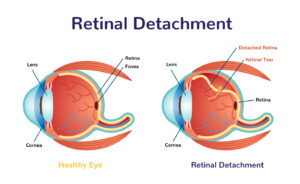Guest Blog: When Do You Need Retinal Detachment Surgery?


Our eyes are like a window through which we view the world around us, and we are heavily dependent on them to conduct day-to-day activities. We shouldn’t take any injury or damage to the eye casually and should take immediate consultation when anything goes wrong with them. Even a minor injury can lead to loss of vision.
One such issue that might go unnoticed and result in permanent blindness is retinal detachment. It is the peeling of the retina from the wall of the eyes, usually due to trauma, short sight, or other age-related changes happening in the eyes. Although one might not feel pain but might notice a shadow coming into the vision as the retina peels away. Other symptoms in the initial stages of this injury are flashes of light in one, or both eyes reduced peripheral vision, and the appearance of floaters (specks) that seem to drift through your vision.
People in older age groups usually suffer from this and have to undergo retinal detachment surgery. The treatment depends on the amount of detachment and tear. While minor tears can be sealed with laser surgery or cryotherapy, those whose tears are more profound need to undergo retinal detachment surgery to seal the tears and get their vision restored.
Different Retinal Detachment Treatments
If the condition is only a little serious, pneumatic retinopexy is used to inject a bubble of air/gas into the center of the eye as it pushes the retina into its correct position, and then the bubble reabsorbs on its own. If the tear is more serious, scleral buckling treatment opts as it involves placing a silicone implant (band or buckle) over the affected area to close the retinal break.
Lately, vitrectomy surgery has become the gold standard for most retinal detachments as the treatment’s success rate is nearly 90%. This retinal detachment surgery is carried out by making three small incisions in the whites of the eye the sclera (it can be combined with a scleral buckling procedure) so that the surgeon has access to the space behind the lens. The transparent jelly (vitreous) is removed from the eye; the retinal break is closed by laser or cryotherapy, and air, gas, or silicone is filled in the vitreous space to help flatten the retina. Air and gas are eventually replaced by body fluid. Silicon oil, if injected, has to be removed by a minor surgical procedure at a later date.
These treatments are surely effective in restoring vision if the tear is diagnosed at an early stage. But without proper (timely) treatment, the majority of acute retinal detachments result in complete loss of vision and permanent vision loss. The retinal detachment surgery recovery time can vary from a few weeks to several months as your eyes need proper rest and healing for the vision to be restored, and even then, complete recovery is difficult because it is dependent on how quickly we reattach the retina.
